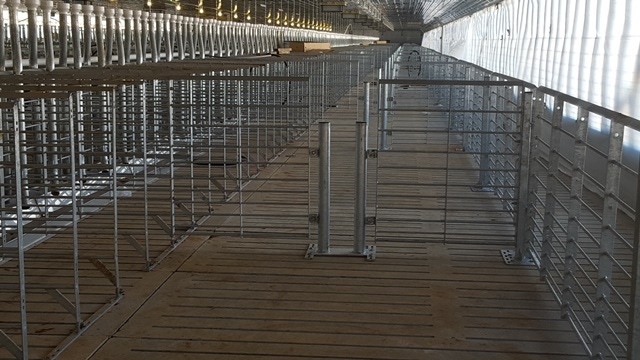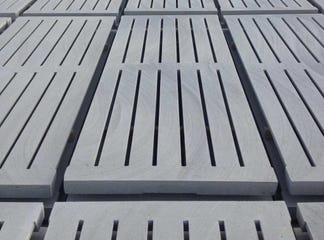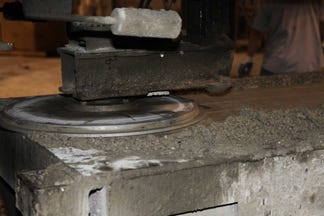Quality flooring and maintenance play a key role in reducing lameness in swine herds.

A major cause of foot injuries in swine of all ages is poor flooring. A housing system can greatly influence the amount of physical trauma to the animal’s body, particularly the joints. The type of flooring can have a great impact on lameness and joint health in general.
Jim Lowe, DVM, Integrated Food Animal Medicine Systems at the College of Veterinary Medicine at the University of Illinois, says it really comes down to the “quality” of the flooring and how that floor is maintained. A clear assessment of your current flooring is worth the time to determine if actions can be taken to help reduce lameness-related incidents on the farm.
As production models evolve and vary from farm to farm, the challenge is finding the correct flooring for your individual operation. As some farms transition into alternative housing, the flooring will be an important detail requiring close attention. Sows in group housing systems tend to have more injuries, especially older sows. While other factors such as genetics can also play a part in lameness, poor flooring is a main reason for physical trauma. In addition, research at the Prairie Swine Centre at Saskatoon, Saskatchewan, shows that comfortable flooring impacts several aspects of an animal’s welfare, including laying behavior, an animal’s ability to change postures, and incidence of lameness and lesions.
Assess the situation
Whether you are evaluating your current flooring in a unit or considering new construction, there are certain aspects to consider. A good place to start is to determine if the floor type is suitable for the age and weight of the pigs. A determination of the location, size and suitability of the sleeping area that would ensure a dry space for animals to rest needs to be made.
In current flooring systems, the following things are necessary to check on a routine basis.
■ Examine floor surface for cracked or rough areas. Areas to pay close attention to are around the waterers and feeders.
■ Check the condition of the slats, particularly the edges and the gaps between slats.
■ Inspect the condition of the facility. This should include the gates and pens. It should also include examining building supports, since damage can occur from the pigs.
■ Check the cleaning and disinfection routine.
It is important to develop a schedule for inspecting the facility, along with maintaining the floor regularly. Regardless of the individual who conducts the inspection, the results need to be documented and available to team members to ensure repairs are made and areas to watch are closely monitored.
Type of flooring
The type of flooring is really a matter of the right design for the individual hog operation. One question to ask is how the farm intends to handle the manure. For instance, if manure is handled in a solid or semi-solid form, then the floor option is usually solid. If manure is to be handled as liquid, then the floor type is slatted or partially slatted.
Slatted floors are the most popular in modern production because they reduce the labor associated with solid flooring. The amount of slatted floor is centered on the management practices and the individual producer’s preference. For systems with under-house manure pits, partially slatted floors are not practical due to limited storage capacity.
Slatted floors should be designed to minimize pig injury and maximize cleanliness. The width of the slats varies from 4 to 8 inches, depending on the purpose of the facility. Slats used for farrowing are 4 to 5 inches wide, nursery slats are 4 to 6 inches wide, and grow-finish slats are 5 to 6 inches wide.
Overall, the slat widths of 7 and 8 inches have been successful over time in both gestation and growing-finishing pigs, and studies have shown that 8-inch slats reduce injury to feet and legs.
The decision on what type of slat material to use should be based on cost, durability, easy maintenance, ease on pigs’ feet and legs, and necessary sanitation method.
In general, good flooring should be:
■ smooth, non-slip with an impervious surface
■ quick to drain to provide a dry surface
■ easy to clean and disinfect
Good slat design

Fritz Richards, national sales manager for Hog Slat Inc., says minimizing the discomfort for pigs and the risk of injuries to feet and legs comes down to three things: good concrete slat design, construction and maintenance.
Slat quality becomes an important factor in modern production systems, regardless if your flooring need is for the finishing floor or a group housing system, explains Richards.
He adds the construction of the slat can negatively affect the surface of the flooring. “Many methods used for producing concrete slats consist of placing wet-cast concrete into multiple steel forms and hand troweling to finish. Final finish includes edging the individual sections to fashion a rounded edge. The process of edging creates a slight ‘hump’ in the middle of each slat section. These ‘humps’ create an uneven surface that places additional stress on pigs’ feet and joints as they move across the flooring,” Richards says.
 Moreover, he further explains since machined slats are produced differently, it eliminates the uneven surface found on hand-cast slats. The automated rotoscreens (refer to the photo on right) “strike off” the mold, creating a more level and uniform flat top that is simply easier for the pigs to travel on.
Moreover, he further explains since machined slats are produced differently, it eliminates the uneven surface found on hand-cast slats. The automated rotoscreens (refer to the photo on right) “strike off” the mold, creating a more level and uniform flat top that is simply easier for the pigs to travel on.
“Uniform slat openings are crucial in providing pigs a good flooring surface,” Richards stresses. “A slat opening that varies may allow a pig’s foot to drop into an opening and then get caught if the gap narrows. As the pig struggles to free himself, leg abrasions can occur.”
He adds the machined slats reduce the gap variation because dry-cast slat production requires fewer molds than wet-cast production.
The fact is even the best constructed slats wear over time. Maintaining the slat surfaces and edges is essential in providing a comfortable flooring surface for all animals. Richards says, “Areas around the waters and feeders are the first to show significant damage.”
Paul Vanberg, president of Vanberg Specialized Coatings, says all surfaces in pork production show signs of wear soon after the pigs are moved in. Depending on the type of flooring, the surface can show deterioration immediately or a year later. One way to preserve the floor surface from normal wear is to properly seal a new floor with epoxy overlay to produce a tough-wearing, chemical-resistant surface.

Wear and tear of the floor is bound to happen, and it is not feasible to rip up and replace it. Richards says more cost-effective repair options are available. He recommends choosing a repair mortar design for repairing slats versus generic concrete repair products. These mortar designs are formulated with higher cure strengths and faster cure times (refer to illustration below). For simple repairs with less than one-fourth inch in depth, a cement mortar can be used, but more severe corrosion requires the use of epoxy mortars to hold the repair patch in place, Richards says.
Factors impacting flooring life
Deterioration of the concrete surface can result in a rough surface, sharp edges and enlarged gaps in slatted floors, which is all bad news for pigs’ feet and legs. Research from the Prairie Swine Centre shows there are several factors that influence concrete degradation. First, the original quality of the concrete will have a great impact on the life of a floor. A durable, high-quality concrete with low permeability is best for longevity.
The frequency of cleaning and the cleaning method all affect concrete deterioration, especially with disinfection solutions with high concentration of alkalines or hydrochloric acid. Hog producers should evaluate cleanliness and moisture because manure buildup can lead to foot infections, softening of the claws, hoof wall cracks and excess wear.
Another factor is the feed and the feeding system. Different feeding ingredients have varying pH levels. In addition, the distance between feeder and water supply can also impact flooring life. Take a realistic look at the feeders, water supply and layout design, along with the erosion pattern, to determine if adjustment needs to be made to the facility or management practices.
About the Author(s)
You May Also Like


